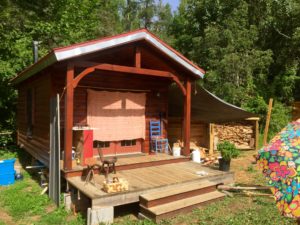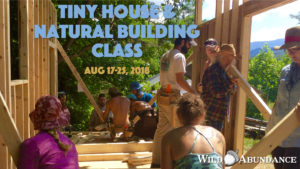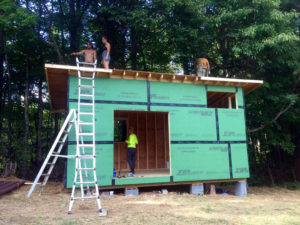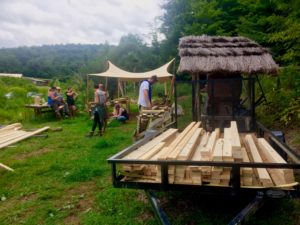We suspect a lot of you are just as excited about tiny houses as we are. That’s why we’re going to walk you through how to build your own tiny house in 5 basic steps.
Step 1: Dreaming and Designing Your Tiny House
Before you pick up a hammer or go buy a trailer, make a plan. As with any project, it’s worth spending time creating a solid design for your tiny house.
Ask yourself what you do most often in your home, or what would you like to do? Sleeping is obviously a necessity, as is eating. But do you love to cook and entertain, or are you happy with a kettle and a toaster oven? Would you feel comfortable sleeping in a loft, or are you claustrophobic or scared of heights?
Tiny houses are, well, tiny, so it’s really helpful to design for efficient use of space. How to build your own tiny house depends on your unique, personal needs.
Try to think outside the box of a “normal” house. For me, I would be happy with mostly kitchen, a loft to sleep in, and a little bit of storage space. You might not be so into cooking, but way more into reading, writing or crafting. In that case, you’d need to make sure to have a nice big table with lots of shelves and cubbies for books and craft supplies. See what I mean? It’s helpful to consider the differences between tiny houses and traditional houses when you’r asking yourself these questions.
Some clever tiny house space-saving ideas:
- Stairs with drawers beneath them
- Putting a bathroom above your space for a water heater or other utility area
- Bookshelves above wheel wells (if you’re building on a trailer)
- Loft over a hang-out space
- Couch under the stairs
- Corner sinks are awesome!
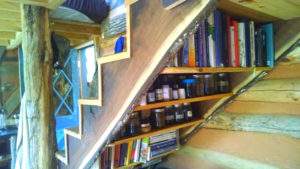

Other space-saving ideas that aren’t worth it:
- Vertical ladders
- Tiny lofts
- Skipping storage space of any kind (unless you plan to have a separate storage building or trailer..which we highly recommend)
Practical design considerations when you build your own tiny house
- How tall and wide can you build, legally, if you are taking this puppy on the road?
- Will you build on a trailer or on skids? “What the heck are skids?”, you’re wondering… They’re heavy timbers that run the length of the building and bear its entire weight. It’s a bigger project to move a tiny house on skids and requires some special equipment, but you can save a ton of money by skipping the trailer. If you don’t expect to move your house around a lot, skids are a great choice.
- Are there windows or doors that you have on hand that you’d like to incorporate (what are their specific dimensions)?
- Do you plan to add porches or other connecting structures down the line?
- How will you heat your tiny house?
During our tiny house workshop, we talk about all these factors, and others, including incorporating natural and sustainable building materials. So, if you want some help figuring it all out, sign up and share the fruits of our instructors’ decades of experience.
Step 2: Gather Materials For Your Tiny House
Your tiny house can be a fantastic place to use that really awesome window you found at a garage sale, or that super cool old barn wood you’ve been hauling around since your grandpa sold the old homeplace. Because they’re small, tiny houses can boast just one of one kind of window or a small amount of one kind of trim without looking too ramshackle.
In fact, after you make a preliminary design, the very first thing you should do is start shopping for used doors and windows. These can be some of the most expensive parts of your tiny house. You can save a massive amount of money by buying them used. But make sure to check out the new prices for things before you start salvaging. Just because something is used doesn’t mean it’s a deal. Sometimes it can be just fine to by buy a certain door or window new if the used prices are comparable.
Your final elevation drawings (you can learn how to make these at the tiny house workshop) will include your new windows.
Salvage yards, garage sales, Habitat for Humanity, and Craigslist are all good places to look for materials when you’re ready to build your own tiny house. Tiny house amounts of flooring and roofing can usually be found at special discount outlets. Even something like insulation is possible to get at a deal because you will only need an amount that would be awkwardly small for a full-sized building.
Lumber for framing your tiny house is usually best bought new, either from a building supply store or directly from a sawmill. If you have forested land, milling your own wood or having it milled is an option, too.
Step 3: Building Skills, Tiny House Style
It doesn’t take all the skills you would need to build a “regular” house to build your own tiny house. That doesn’t mean you don’t need skills. Basic carpentry skills are essential. Decent tools are important, too.
If you are a woman and you don’t feel comfortable with carpentry, check out our women’s basic and advanced women’s carpentry classes. We’ll help get you up to speed so you feel confident building your own tiny house. For all genders, chances are you have some friends who might show you the basics. Usually people enjoy having help with carpentry projects, if you’re willing to do “boring” tasks like fetching tools and holding stuff. Pay attention, and you’ll learn a ton.
How to build your own tiny house doesn’t depend on carpentry alone. Other, more specialized skills that may be needed are: roofing, electrical and plumbing. Never underestimate the power of YouTube to guide you through even the most complex of building tasks. That said, if you plan to plumb and electrify your tiny house, those are areas where getting professional guidance can be well worth it.
Step 4: Tools You Need… and Some You Don’t
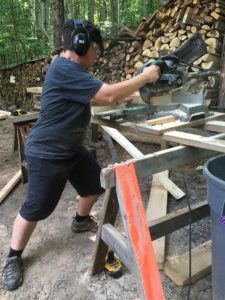

Tools matter. True, they can be expensive, but the right tool for the job can make the difference between a pleasure and a pain-in-the-ass. Some more expensive. Specialized tools are worth borrowing or renting instead of buying.
Tools you will absolutely need to build your own tiny house:
- Tape measure. We strongly recommend the Stanley brand “Fat Max.” Do not get a tape measure that claims to be “self-centering,” as these lead to confusion.
- Safety glasses
- Ear protection
- Dust mask (if you have sensitivity to dust)
- A bevy of carpenter’s pencils
- Several “Sharpie” felt-tip pens
- Tool belt or apron
- Speed square (actually shaped like a triangle)
- Tool bucket or tool bag
- Impact driver and/or drill (Makita, deWalt, Ryobi and Bosch are the only ones we recommend) with bits and drivers (especially t20 and t25 star drive). The impact driver is far superior to the drill when it comes to driving screws. You can purchase special drill bits that will fit into an impact driver. So, if you have to pinch pennies and only get one, go for the impact driver.
- Hammer. Don’t get a macho giant one; it may give you tendonitis. In our tiny house workshop, we do a lot more screwing than hammering, but we still recommend getting yourself a hammer, as they come in handy for lots of projects.
- Pull saw (often called a “Japanese pull saw,” though some are made in the USA)
- Circular Saw (don’t bother with the battery-powered ones; they are sissy)
- Chalk line
- Levels: 10-inch, 2-foot, 3-foot and/or 4-foot
- Framing square (actually shaped like an L)
Tools that can be borrowed instead of bought if your budget is small (in order from most to least important):
- Chop saw or sliding miter saw for wood
- Table saw
- Chisels
- Jig saw
The small size of tiny houses means that you won’t have to repeat even the most repetitive parts of building that often. You won’t need some of the labor saving tools professional home builders use, like pneumatic or air-powered nail guns. If you can borrow one, it can be helpful, but it’s not worth investing in. Other fancy tools you can do without are a planer, a jointer and a router.
You will get a chance to check out and learn to use all of these tools at our tiny house building workshop.
Step 5: A Place to Build Your Own Tiny House
One of the coolest things about tiny houses (most of them) is that they are moveable. That means where you build it and where it ends up, with you happily living inside of it, doesn’t have to be the same spot. This can be handy, especially if your tiny house’s ultimate landing pad doesn’t have, say, electricity. While it is possible to build your own tiny house without using power tools, it’s a whole lot easier and faster with them.
Find a place to build your own tiny house that has electricity, is easy to drive up to, has enough flattish space around it to store materials, and is located where you can rig up some kind of rain and/or sun protection.
If you know someone with one of those super tall carports meant for an RV, they could be a good person to sweet-talk. Perhaps they’re willing to park their precious RV out in the elements for a few weeks, thus freeing up a Taj Mahal of a tiny house building zone for you. You might even want to buy one of these jumbos, or just a regular carport, for your project. It could be used now to work under and store materials, then when you are done with your building project, it could become an outdoor kitchen, a workshop or even a carport. They cost about $1,000. If you have the option, get one that has a roof overhang, which can be very useful if you ever want to put walls up to protect the inside from rain.
How your orient your tiny house at the building site is important, too. If you are planning to move it later, it needs to be accessible by a truck. The fingernail-biting experience of moving your newly completed tiny house will be easier if it’s not in a super tricky spot that requires lots of maneuvering.
Build Your Own Tiny House!
Wow, can you believe that minutes ago when you started reading this post, your tiny house was just a dream and now you’re ready to build?! Okay, that’s a little bit of an exaggeration, but seriously, you can build your own tiny house by following these basic steps. If you want some more detailed instruction, including a tour of several finished and in-the-works tiny houses, jump in on our Tiny House and Natural Building Workshop. Good luck, and happy building!
